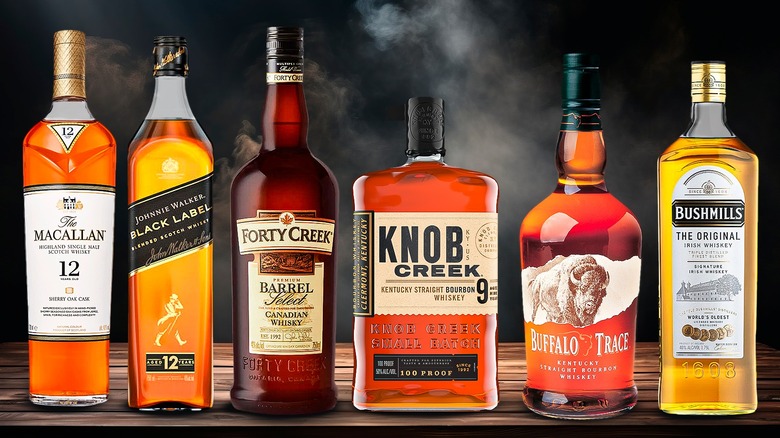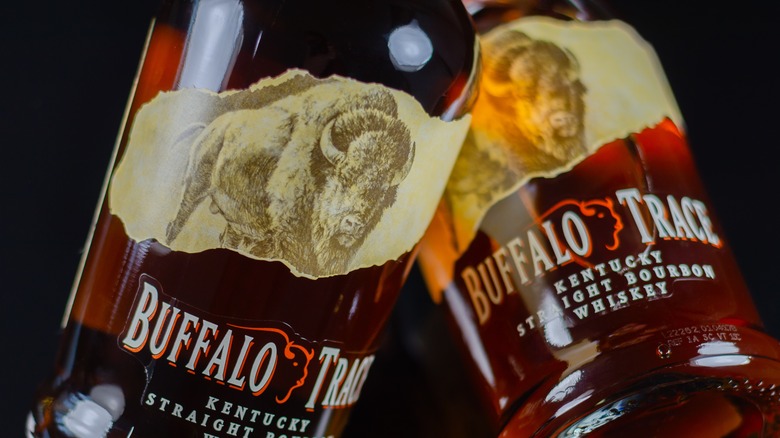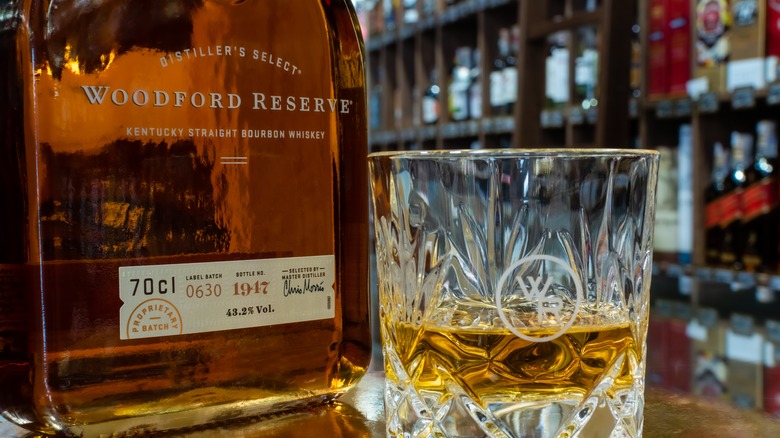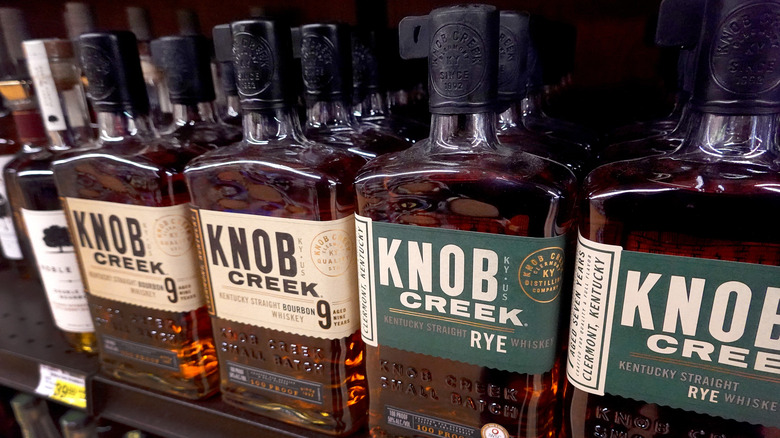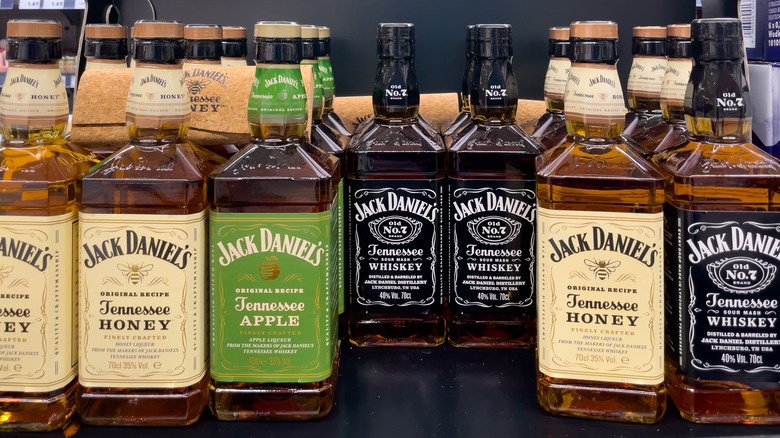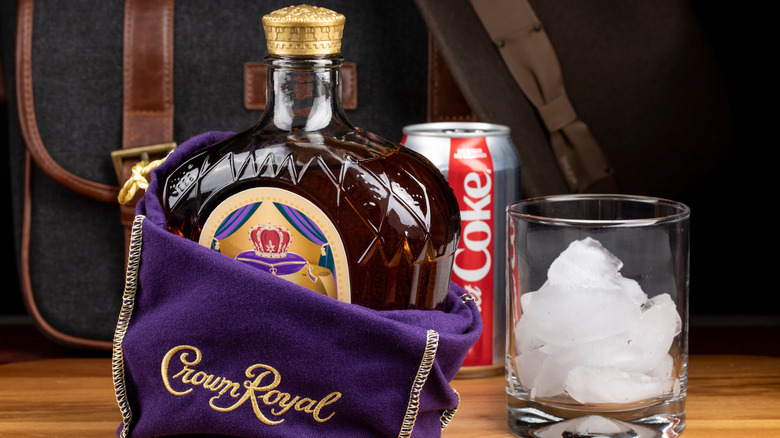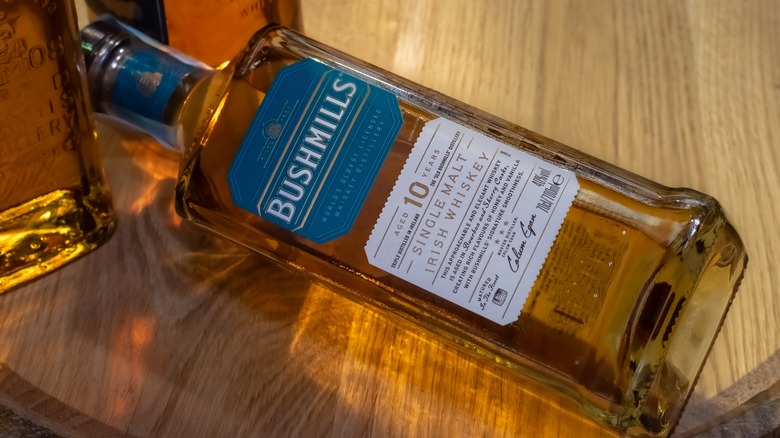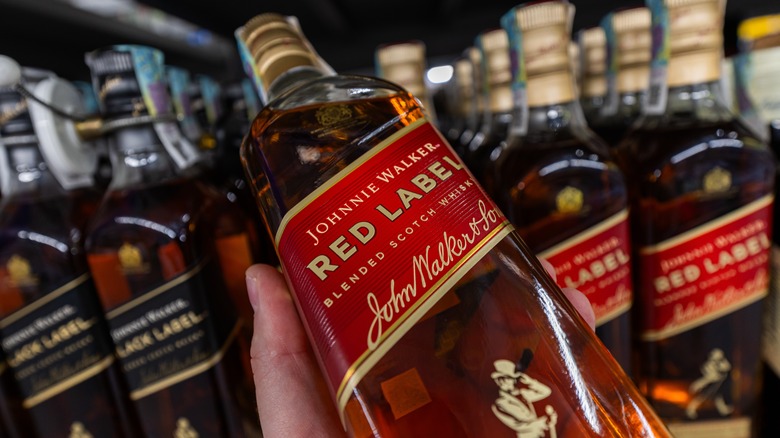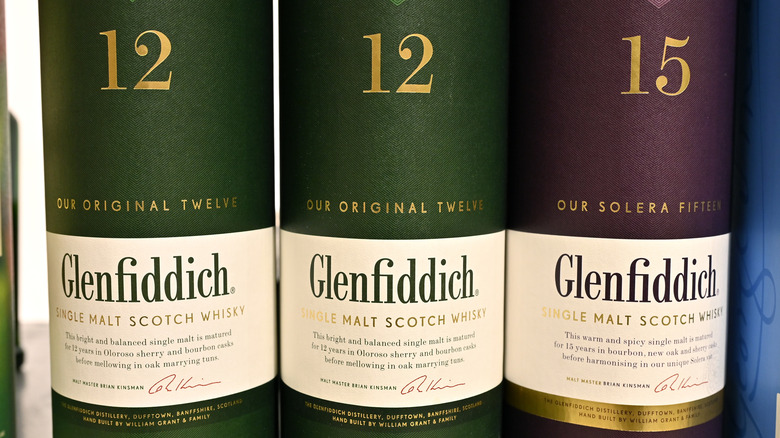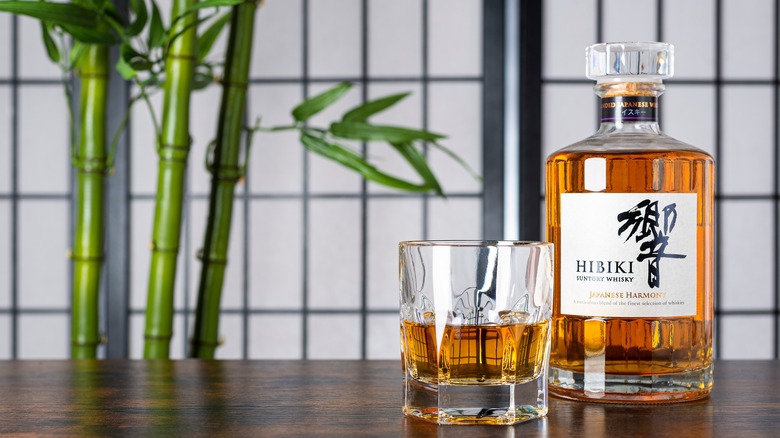The Must-Know Whiskey Brands For Beginners
Whiskey is a whole world. If you're just dipping your toes in, you may already be overwhelmed by the sheer volume of choices, not to mention all the different classes of whiskey out there. Do you spell it "whisky" or "whiskey?" Is there actually a difference (the answer is yes, regionally speaking, but not really)? What's the difference between Irish, Japanese, American, and Canadian whiskey? Do you want a bourbon or a rye when you're whipping up a cocktail? And what is Scotch anyway? Single malt or blended?
To break down some must-know labels, we spoke with bartenders Torrance Coombs and Meg Messer, as well as Jennie Wilson, co-owner and head of the beverage program at the 11th Mile restaurant in Fredericton, New Brunswick. They weighed in on the classics, shared personal favorites, and also gave us some tips on which whiskey to use in classic whiskey cocktails.
When asked simply which whiskies everyone should know about, Wilson demurs, "It's a question you're not going to be able to answer without a lot of argument ... You would think these things are fixed facts, but they're not." Whiskey aficionados are passionate about their spirit of choice, and Wilson, Messer, and Coombs make no claims to have the definitive word of the subject. Personal taste has a lot to do with it, so you'll likely have to taste a few before you know what you really want to keep on your bar. We've done some of the legwork for you to break down the best options, but having a favorite whiskey is pretty cool, so we think you'll enjoy your homework.
Buffalo Trace and Wild Turkey 101 bourbon
Both Jennie Wilson and Torrance Coombs start with bourbon. "I would say we lean more heavily ... towards bourbons out of all the whiskies," Wilson told us, "and our very favorite bourbon is Buffalo Trace without a doubt." Buffalo Trace Kentucky Straight Bourbon has been distilled from corn, rye, and barley malt for over 200 years at "the world's most decorated distillery." It named its spirit for the majestic animals whose migration route crossed the Kentucky River right at their location in Franklin County. Wilson says they use Buffalo Trace in whiskey sours, New York sours, brown derbies, and any other "classic bourbon drinks where you just want a nice American bourbon without surprising taste profiles." Try a paper plane if you like Aperol!
Bourbon is, by definition, whiskey made from at least 51% corn and aged in charred oak barrels. To be labeled "straight" bourbon, it must be aged at least two years. It's a traditionally American whiskey associated specifically with the state of Kentucky. While most bourbon is made in Kentucky, it can technically be made anywhere in the U.S. Maker's Mark, Bulleit, and Four Roses are other common bourbons, all made in Kentucky.
Torrance Coombs says, "the value in whiskies I think is mostly in American whiskies like bourbons and ryes." His go-to affordable bourbon is Wild Turkey 101. "It's got a burn to it," he says, "But it's tasty. It's like that burn that wakes your face up in a good way." Wild Turkey 101 is aged for six to eight years in American White Oak barrels that have been coated in alligator char in Lawrenceburg, Kentucky.
Baker's, Blanton's, and Woodford Reserve premium bourbons
For a nicer bottle of bourbon, Jennie Wilson says she'll pick up Baker's or Blanton's. If you're not mixing it into a cocktail and you want to sip something straight up, those are the two "more special" premium bourbons that she would gift someone, she told us. Baker's is a single barrel bourbon — it doesn't batch or mix its whiskey, and the company says that means "inside each bottle is a big, bold bourbon, full of tiny subtle details that change barrel to barrel." However, Blanton's claims to have originated the single barrel bourbon in 1984 when Master Distiller Elmer T. Lee started bottling "super premium" bourbons this way.
Torrance Coombs' favorite bourbon is Woodford Reserve, a premium small batch bourbon made from 72% corn. Woodford's distillery is a national historic landmark. "It doesn't need anything," says Coombs, "you can just sip it neat. It's got a sweetness to it also that makes a good old fashioned, but ... you can just sip some Woodford and it's delicious, and it doesn't completely break the bank."
You can sip any kind of liquor if you feel like it, but it does seem that whiskies tend to find themselves neat or on the rocks more often than other spirits. Ordering one straight up can feel pretty classy, or even like a power move. So, if you find you like the brown stuff and you're leaning into bourbon, check if these premium options are available.
Lot No. 40, Knob Creek, Bulleit, and Old Forester Rye
Rye is similar to bourbon in many ways. They are both aged in charred new-oak barrels, with nothing but water added, and many contain both corn and rye grain mash. While bourbon must be at least 51% corn, however, rye is made from — you guessed it — majority rye grain. Many of the same labels will make a bourbon and a rye whiskey. They are similarly used in many classic cocktails, and if you want a Manhattan, for instance, you'll likely want to use rye.
Jennie Wilson gives a shout out to J.P. Wiser's Lot No.40, a Canadian 100% rye, and her rye of choice for the bar at 11th Mile. She says it "brings a nice peppery note" to cocktails. Bartender Meg Messer also goes for Knob Creek, which makes both bourbons and ryes. Knob Creek is aged for 7 years before bottling, and "its high corn mashbill makes it perfect for the bourbon drinker looking to add a rye to their liquor cabinet."
Asked what he'd grab in the rye department, Torrance Coombs says his favorite is Bulleit rye. Bulleit is an American brand based in Louisville, Kentucky, that — again — makes both bourbon and rye. The bourbon comes with an orange label around their signature canteen-shaped bottles, and the rye has a green label. Go for the green, he says. It makes for a delicious old fashioned, sazerac, or whiskey ginger. "It's because the rye has a little bit of, like, a spiciness to it ... aromatic and kind of, like, peppery..." He gave another shout out to Old Forester rye.
Jack Daniels Tennessee whiskey
Tennessee whiskey is not just a famous country song, it's another class of whiskeys that crops up regularly in the U.S. "I think Tennessee whiskey is just basically you've made bourbon but you've made it in Tennessee instead of Kentucky," says Torrance Coombs. In some international trade agreements, it is literally defined as a class of bourbon. Coombs says it's "similarly delicious and honestly ... I think Jack actually holds up pretty well." He's talking about Jack Daniels, of course.
Made in Tennessee since 1866, there are few alcohol brands more famous. In fact, when you google "Tennessee whiskey," Jack Daniels is just about the first thing that comes up... after the Chris Stapleton rendition of the song, of course. It was the first registered distillery in the U.S. Old No. 7 is the original Jack Daniels sour mash Tennessee whiskey, and it is "charcoal mellowed." The brand started introducing other products in the 1980s, and its flavored whiskies, like Tennessee Apple, Tennessee Fire, and Tennessee Honey, are now commonly available.
The square bottle with the black label is likely to appear just about everywhere. However, there are other smaller labels, and you can explore them along the Tennessee Whiskey Trail. You can collect a Tennessee Whiskey Trail passport to track your journey. Its website can help you plan a route and you can even win a prize if you visit all the participating distilleries. Did somebody say road trip?
Crown Royal, J.P. Wiser, and Forty Creek Canadian whiskey
Canadian Whiskies as a class tend to be blended whiskies, and they're known for their light and smooth taste and finish. Some originally Canadian brands are legendary, and you may recall from history class how the Canadian distillers bootlegged to the Americans during prohibition.
J.P. Wiser (mentioned above) and Seagram's both began in Ontario in 1857. The iconic Crown Royal was created in 1939 as a gift for the king and queen of England. A blend of over fifty different whiskies, Crown Royal entered U.S. markets in the '60s and is one of the top selling Canadian whiskies. Formerly Seagram's Crown Royal, it was bought by beverage conglomerate Diageo in 2000, but it's made in Canada to this day from around 80% grain sourced locally in Canada. You'll often find it sold in its signature purple bag.
Jennie Wilson's personal favorite, Forty Creek, is a Canadian label that has its roots in 1972. Forty Creek makes several whiskies, but she specifically recommends its Copper Pot (now known as Copper Bold) whiskey. Released by Forty Creek in 2007, this spirit was meant to continue the distillery's mission of "pushing the boundaries of Canadian whisky." It's blended from three different types of grain whiskies, which are individually aged. The brand was acquired by Campari Group in 2014, but it's still produced in the Niagara region of Ontario. Wilson says it's especially nice "if you're doing like some kind of warm cider or 'an apple-y style drink.'" Come fall, bust out the Copper Pot and get cozy.
Bushmills and Jameson Irish wiskey
Irish whiskies come from Ireland, no surprise there. Like Scotch, they are made from mostly malted barley with other grains like wheat and corn mixed in. When it comes to these whiskies from Ireland and Scotland, the term "single malt" refers to whiskies made from 100% malted barley in pot stills by a single distillery. Grain whiskies use wheat or corn, blended whiskies combine single-malt and grain whiskies, and single pot still whiskey is a uniquely Irish whiskey distilled from both malted and unmalted barley. They are all aged in wooden casks and typically triple distilled.
"Bushmills is our preferred Irish whiskey on the bar," says Jennie Wilson. Licensed in 1608, Bushmills has the oldest licensed whiskey distillery in the world. Named for the Bush River, it's been triple distilling whiskey in copper pot stills for over 400 years. However, Jameson is the Irish whiskey in the dark green bottle known the world over. Starting in 1780, Jameson made its whiskey in Dublin and later moved to Cork, where it remains to this day. While it's not on the bar at 11th Mile, Wilson says, "Personally I loved it." Irish whiskies are the go-to for a hot boozy beverage. Irish coffee, anyone?
Johnnie Walker and The Famous Grouse blended Scotch
The Famous Grouse blended scotch is what Jennie Wilson uses for her famous penicillin cocktails. Famous Grouse has been made in Perthshire, Scotland since 1896. Its signature blend is aged in oak casks at "a higher temperature to deliver a soft, warm depth of flavour, with bright fruity notes." It also uses different casks from different woods to make its special "cask series," and currently features one aged in sherry casks.
One of the most commonly sold and widely known brands of scotch whiskey is Johnnie Walker. John Walker started blending whiskies at his grocery store in Kilmarnock in the early 1800s. His son, Alexander, went on to create the brand and its signature slanted label in 1867. They entered worldwide markets and spread throughout the 20th century, becoming the most popular blended Scotch whiskey. Today, it is owned by Diageo and is first on the list when you visit the Our Brands page on their website. You can visit Johnnie Walker Princes Street, Edinburgh, and experience immersive tastings, cellar tours, and even Michelin star pairing menus. The brand features different tiers, or "labels," that range from affordable to rather expensive. The scale goes from Red Label, Black label, Double black, Gold label, Platinum, and at the top of the ladder is Johnnie Walker Blue Label. For Wilson, Red Label will do just fine on the bar. It's her basic blended scotch for making mixed drinks.
The Macallan, Dalmore, and Glenfiddich Single Malt Scotch
Scotch really is a whole world within worlds. Scotches are whiskeys produced in Scotland, and must be aged at least 3 years, though most are aged much longer. Interestingly, many Scotches are aged in ex-bourbon barrels. Whether they're made near the coast or inland can have an affect on their character. Many Scotches also have a distinctive "smoky" or "peaty" scent and flavor, which is the product of drying the barley over peat smoke during the malting process.
"Once you start scratching the surface it almost becomes like being a sommelier," Jennie Wilson says. For those looking to sip a scotch straight up, neat or on the rocks, 11th Mile keeps The Macallan 12, Glenfiddich 15, and The Dalmore 15 on the bar. We'd add Glenlivit, Glenmorangie, Oban, Laphroaig and Lagavulin to the list of must-know brands, but that list goes on and on.
Those numbers on the label refer to the number of years a Scotch has been aged. That's the thing about Scotch, more so than with other whiskies — there's a great focus on aging. Whiskies take on flavor from the barrels they are aged in. Nowhere is this more true than with scotch. Typically, the older a scotch is, the more it's going to cost you.
Suntory and Nikka Japanese whiskey
The Japanese whiskey scene developed largely thanks to Masataka Taketsuru, who studied in Scotland from 1918 to 1920. He apprenticed at several Scotch distilleries, and brought that knowledge home to the other island empire. Taketsuru worked for Shinjiro Torii at Kotobukiya Limited (Suntory), helping it build the first whiskey distillery in Japan until he founded his own distillery in 1934 and developed Nikka whiskey. To this day, those two labels are the backbone of an increasingly diverse whisky culture. Both distilleries produce many different whiskies, single malt and blended. While Japanese whiskies still tend to resemble Scotches in several ways, they have a reputation for being quite refined and can have a more experimental quality today. Distilleries produce many blends by working with multiple types of casks, fermentations, and stills.
Japanese whiskey has continued to diversify, growing in international reputation. "Japan produces good whiskies," Torrance Coombs says. "I actually haven't tasted one where I was thinking it wasn't any good, like they're all good." He recommends a newcomer to whiskey might even like to start here. Though the price of Japanese whiskey has risen along with its popularity. Now, whiskey production has spread throughout Asia. You can also find good whiskies made in Taiwan and India, though they're not quite as common in the average American bar...yet, that is!
